Effects of Compositional Inhomogeneity on the Microstructures and Mechanical Properties of a Low Carbon Steel Processed by Quenching-Partitioning-Tempering Treatment
Abstract
1. Introduction
2. Material and Methods
2.1. Material and Specimens
2.2. Testing Conditions
3. Results and Discussion
3.1. Microstructural Evolution
3.2. Mechanical Properties of the Quenching-Partitioning-Tempering Steels
4. Conclusions
Author Contributions
Funding
Institutional Review Board Statement
Informed Consent Statement
Data Availability Statement
Acknowledgments
Conflicts of Interest
References
- Speer, J.G.; Matlock, D.K. Recent developments in low-carbon sheet steels. JOM 2002, 54, 19–24. [Google Scholar] [CrossRef]
- Caballero, F.G.; Bhadeshia, H.; Mawella, K.J.A.; Jones, D.G.; Brown, P. Design of novel high strength bainitic steels: Part 1. Mater. Sci. Technol. 2001, 17, 512–516. [Google Scholar]
- Xu, Y.; Li, W.; Du, H.; Jiao, H.; Liu, B.; Wu, Y.; Ding, W.; Luo, Y.; Nie, Y.; Min, N.; et al. Tailoring the metastable reversed austenite from metastable Mn-rich carbides. Acta Mater. 2021, 214, 116986. [Google Scholar] [CrossRef]
- Ayres, J.; Penney, D.; Evans, P.; Underhill, R. Effect of intercritical annealing on the mechanical properties of dual-phase steel. Ironmak. Steelmak. 2022, 49, 821–827. [Google Scholar] [CrossRef]
- Chakraborty, A.; Adhikary, M.; Venugopalan, T.; Singh, V.; Nanda, T.; Kumar, B.R. Effect of ferrite-martensite interface morphology on bake hardening response of DP590 steel. Mater. Sci. Eng. A 2016, 676, 463–473. [Google Scholar] [CrossRef]
- Tsuchida, N.; Tanaka, T.; Toji, Y. Effect of deformation temperature on mechanical properties in 1-GPa-grade TRIP steels with different retained austenite morphologies. ISIJ Inter. 2021, 61, 564–571. [Google Scholar] [CrossRef]
- Kwon, E.P.; Fujieda, S.; Shinoda, K.; Suzuki, S. Characterization of transformed and deformed microstructures in transformation induced plasticity steels using electron backscattering diffraction. Mater. Sci. Eng. A 2011, 528, 5007–5017. [Google Scholar] [CrossRef]
- Wang, M.M.; Tasan, C.C.; Ponge, D.; Dippel, A.C.; Raabe, D. Nanolaminate transformation-induced plasticity-twinning-induced plasticity steel with dynamic strain partitioning and enhanced damage resistance. Acta Mater. 2015, 85, 216–228. [Google Scholar] [CrossRef]
- Ouchi, C. Development of steel plates by intensive use of TMCP and direct quenching processes. ISIJ Inter. 2001, 41, 542–553. [Google Scholar] [CrossRef]
- Clarke, A.J.; Speer, J.G.; Miller, M.K.; Hackenberg, R.E.; Edmonds, D.V.; Matlock, D.K.; Rizzo, F.C.; Clarke, K.D.; De Moor, E. Carbon partitioning to austenite from martensite or bainite during the quench and partition (Q&P) process: A critical assessment. Acta Mater. 2008, 56, 16–22. [Google Scholar]
- Edmonds, D.V.; He, K.; Rizzo, F.C.; De Cooman, B.C.; Matlock, D.K.; Speer, J.G. Quenching and partitioning martensite—A novel steel heat treatment. Mater. Sci. Eng. A 2006, 438, 25–34. [Google Scholar] [CrossRef]
- Zhang, J.Z.; Dai, Z.B.; Zeng, L.Y.; Zuo, X.W.; Wan, J.F.; Rong, Y.H.; Chen, N.L.; Lu, J.; Chen, H. Revealing carbide precipitation effects and their mechanisms during quenching-partitioning-tempering of a high carbon steel: Experiments and Modeling. Acta Mater. 2021, 217, 117176. [Google Scholar] [CrossRef]
- Li, Y.; Li, W.; Min, N.; Liu, W.Q.; Jin, X.J. Effects of hot/cold deformation on the microstructures and mechanical properties of ultra-low carbon medium manganese quenching-partitioning-tempering steels. Acta Mater. 2017, 139, 96–108. [Google Scholar] [CrossRef]
- Zhang, K.; Zhu, M.Y.; Lan, B.T.; Liu, P.; Li, W.; Rong, Y.H. The mechanism of high-strength quenching-partitioning-tempering martensitic steel at elevated temperatures. Crystals 2019, 9, 94. [Google Scholar] [CrossRef]
- Kumar, G.; Ghosh, S.; Pallaspuro, S.; Somani, M.C.; Komi, J.K.; Mishra, S.A.; Gokhale, A. Fracture toughness characteristics of thermo-mechanically rolled direct quenched and partitioned steels. Mater. Sci. Eng. A 2022, 840, 12. [Google Scholar] [CrossRef]
- Hsu, T.Y. Design of structure, composition and heat treatment process for high strength steel. Mater. Sci. Forum. 2007, 561–565, 2283–2286. [Google Scholar] [CrossRef]
- Wang, X.D.; Zhong, N.; Rong, Y.H.; Hsu, T.Y.; Wang, L. Novel ultrahigh-strength nanolath martensitic steel by quenching-partitioning-tempering process. J. Mater. Res. 2009, 24, 260–267. [Google Scholar] [CrossRef]
- Zhong, N.; Wang, X.D.; Wang, L.; Rong, Y.H. Enhancement of the mechanical properties of a Nb-microalloyed advanced high-strength steel treated by quenching-partitioning-tempering process. Mater. Sci. Eng. A 2009, 506, 111–116. [Google Scholar] [CrossRef]
- Romero-Orozco, A.J.; Taha-Tijerina, J.J.; De Luna-Alanis, R.; Lopez-Morelos, V.H.; Ramirez-Lopez, M.D.; Salazar-Martinez, M.; Curiel-Lopez, F.F. Evaluation of microstructural and mechanical behavior of AHSS CP780 steel welded by GMAW-Pulsed and GMAW-Pulsed-Brazing processes. Metals 2022, 12, 530. [Google Scholar] [CrossRef]
- Srivastava, A.K.; Patra, P.K.; Jha, R. AHSS applications in Industry 4.0: Determination of optimum processing parameters during coiling process through unsupervised machine learning approach. Mater. Today Commun. 2022, 31, 103625. [Google Scholar]
- Pierce, D.T.; Coughlin, D.R.; Williamson, D.L.; Clarke, K.D.; Clarke, A.J.; Speer, J.G.; De Moor, E. Characterization of transition carbides in quench and partitioned steel microstructures by Mossbauer spectroscopy and complementary techniques. Acta Mater. 2015, 90, 417–430. [Google Scholar] [CrossRef]
- Kantanen, P.; Anttila, S.; Karjalainen, P.; Latypova, R.; Somani, M.; Kaijalainen, A.; Komi, J. Microstructures and mechanical properties of three medium-Mn steels processed via quenching and partitioning as well as austenite reversion heat treatments. Mater. Sci. Eng. A 2022, 847, 16. [Google Scholar] [CrossRef]
- Qin, S.W.; Liu, Y.; Hao, Q.G.; Wang, Y.; Chen, N.L.; Zuo, X.W.; Rong, Y.H. High carbon microalloyed martensitic steel with ultrahigh strength-ductility. Mater. Sci. Eng. A 2016, 663, 151–156. [Google Scholar] [CrossRef]
- Qin, S.W.; Liu, Y.; Hao, Q.G.; Zuo, X.W.; Rong, Y.H.; Chen, N.L. Ultrahigh Ductility, High-Carbon Martensitic Steel. Metall. Mater. Trans. A 2016, 47A, 4853–4861. [Google Scholar] [CrossRef]
- Chen, L.Q.; Zeng, Z.Y.; Zhao, Y.; Zhu, F.X.; Liu, X.H. Microstructures and high-temperature mechanical properties of a martensitic heat-resistant stainless steel 403Nb processed by thermo-mechanical treatment. Metall. Mater. Trans. A 2014, 45A, 1498–1507. [Google Scholar] [CrossRef]
- Luo, W.T.; Wang, L.L.; Wang, Y.H.; Meng, L.; Yuan, Y.; Zhang, L.; Wu, G.L. Microstructure and mechanical properties of a 2 wt% Nb bearing low carbon steel. Mater. Sci. Eng. A 2021, 826, 141957. [Google Scholar] [CrossRef]
- Carter, C.B.; Williams, D.B. Transmission Electron Microscopy: A Textbook for Materials Science, 2nd ed.; Springer Science: New York, NY, USA, 1996. [Google Scholar]
- Zhong, N.; Wang, X.; Rong, Y.; Wang, L. Interface migration between martensite and austenite during quenching and partitioning (Q&P) Process. J. Mater. Sci. Tech. 2006, 22, 751. [Google Scholar]
- Chang, Y.; Li, G.; Wang, C.; Li, X.; Dong, H. Effect of quenching and partitioning with hot stamping on martensite transformation and mechanical properties of AHSS. J. Mater. Eng. Perform. 2015, 24, 3194–3200. [Google Scholar] [CrossRef]
- Morito, S.; Huang, X.; Furuhara, T.; Maki, T.; Hansen, N. The morphology and crystallography of lath martensite in alloy steels. Acta Mater. 2006, 54, 5323–5331. [Google Scholar] [CrossRef]
- Li, Y.; Baker, T.N. Effect of morphology of martensite-austenite phase on fracture of weld heat affected zone in vanadium and niobium microalloyed steels. Mater. Sci. Technol. 2010, 26, 1029–1040. [Google Scholar] [CrossRef]
- Jones, S.J.; Bhadeshia, H. Kinetics of the simultaneous decomposition of austenite into several transformation products. Acta Mater. 1997, 45, 2911–2920. [Google Scholar] [CrossRef]
- Scott, C.P.; Drillet, J. A study of the carbon distribution in retained austenite. Scr. Mater. 2007, 56, 489–492. [Google Scholar] [CrossRef]
- Ostash, O.P.; Kulyk, V.V.; Poznyakov, V.D.; Gaivorons’kyi, O.A.; Vira, V.V. Influence of the modes of heat treatment on the strength and cyclic crack-growth resistance of 65G steel. Mater. Sci. 2019, 54, 776–782. [Google Scholar] [CrossRef]
- Van Slycken, J.; Verleysen, P.; Degrieck, J.; Bouquerel, J.; De Cooman, B.C. Dynamic response of aluminium containing TRIP steel and its constituent phases. Mater. Sci. Eng. A 2007, 460, 516–524. [Google Scholar] [CrossRef]
- Gao, G.H.; Zhang, H.; Gui, X.L.; Luo, P.; Tan, Z.L.; Bai, B.Z. Enhanced ductility and toughness in an ultrahigh-strength Mn-Si-Cr-C steel: The great potential of ultrafine filmy retained austenite. Acta Mater. 2014, 76, 425–433. [Google Scholar] [CrossRef]
- Zhang, J.Z.; Cui, Y.G.; Zuo, X.W.; Wan, J.F.; Rong, Y.H.; Chen, N.L.; Lu, J. Dislocations across interphase enable plain steel with high strength-ductility. Sci. Bull. 2021, 66, 1058–1062. [Google Scholar] [CrossRef]
- Zhang, T.Y.; Hu, J.; Wang, C.C.; Wang, Y.; Zhang, W.N.; Di, H.S.; Xu, W. Effects of deep cryogenic treatment on the microstructure and mechanical properties of an ultrahigh-strength TRIP-aided bainitic steel. Mater. Charact. 2021, 178, 12. [Google Scholar] [CrossRef]
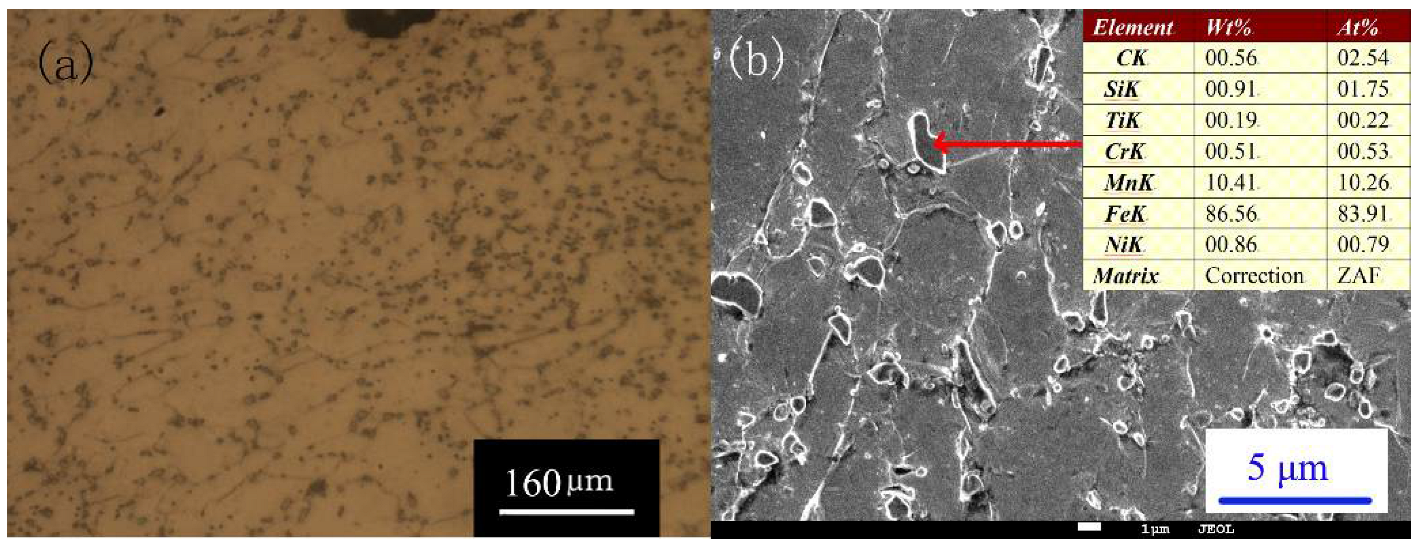
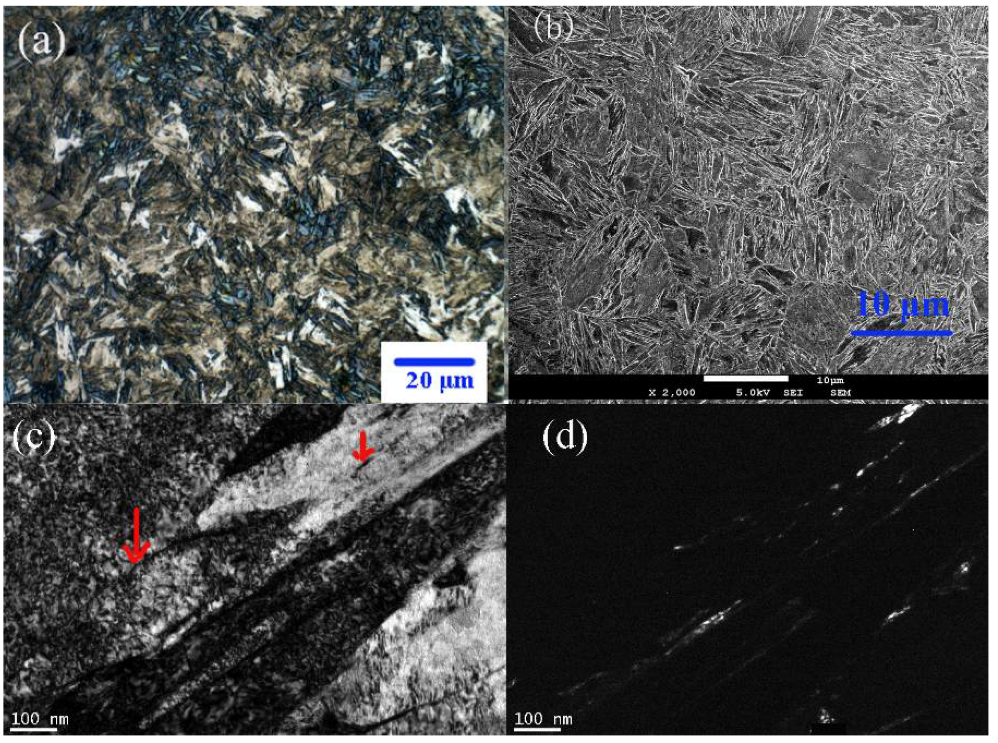

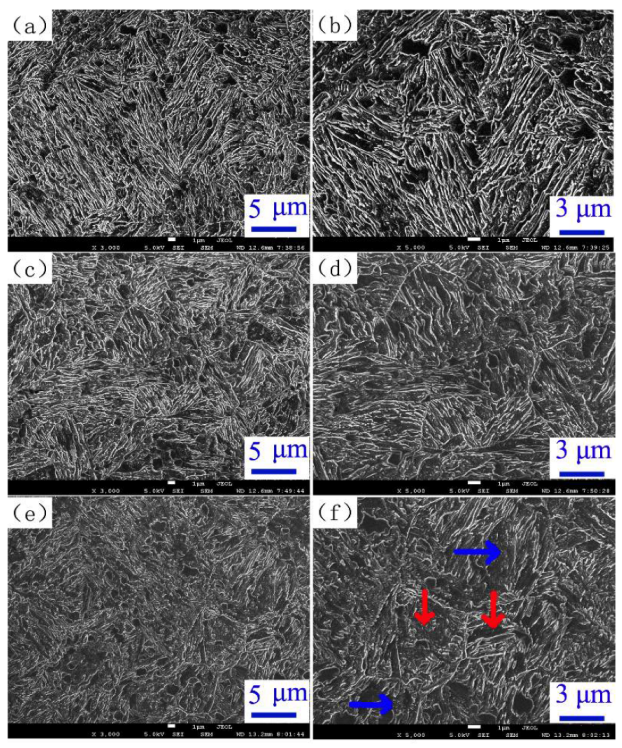

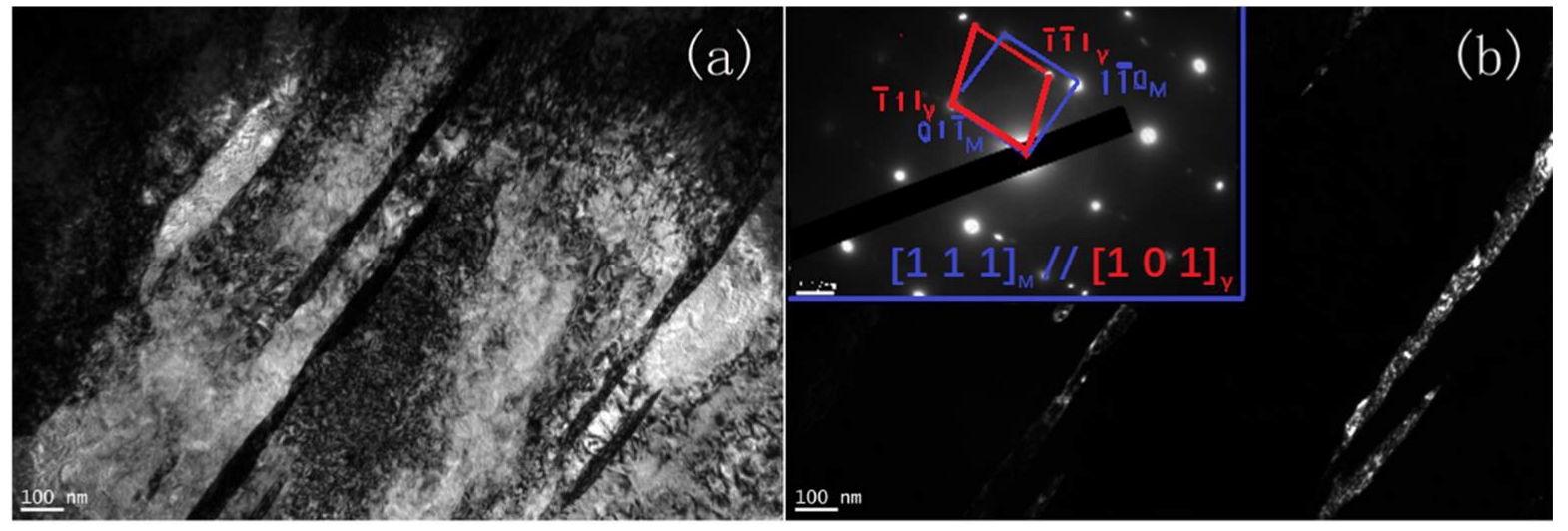

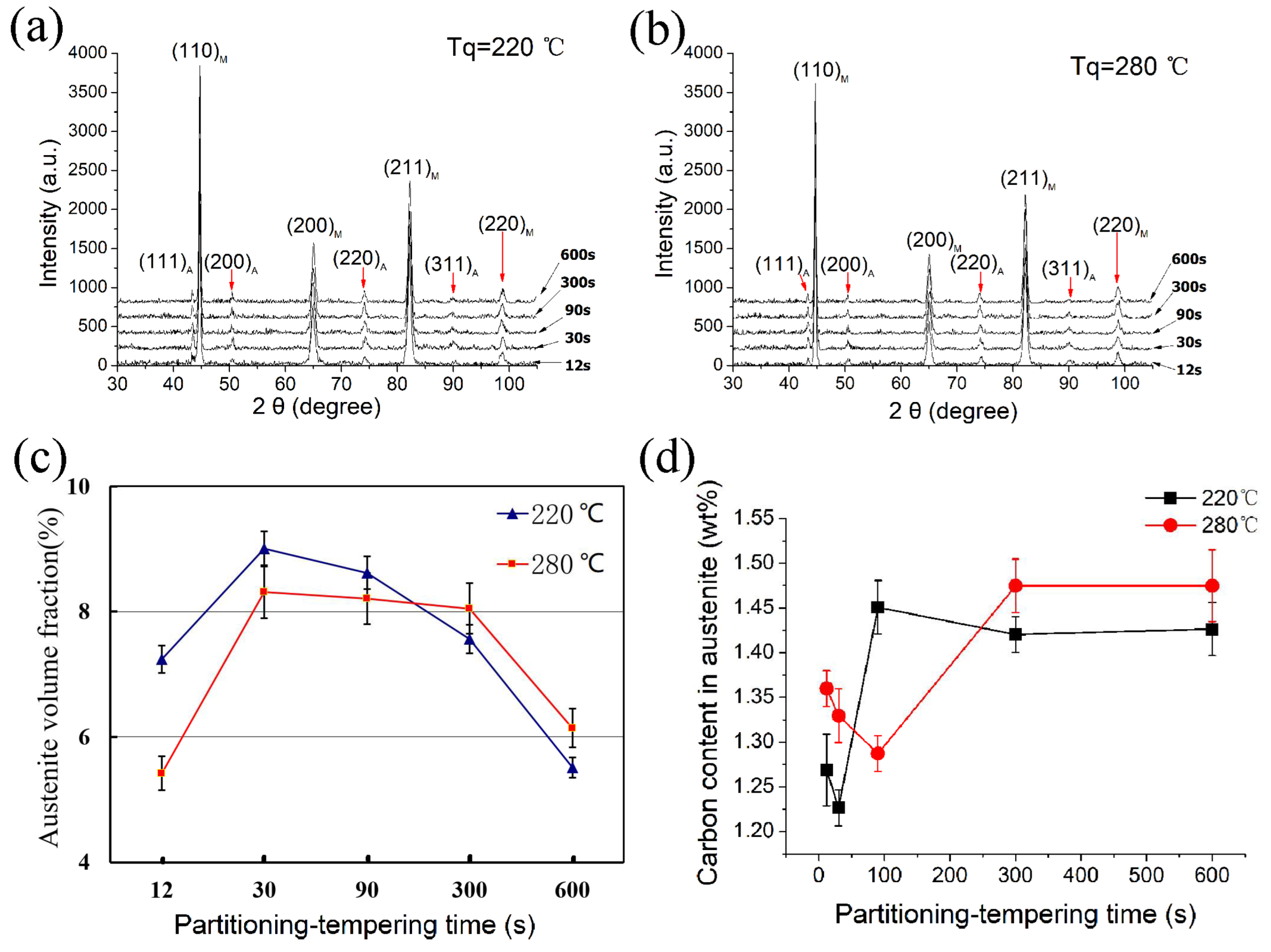
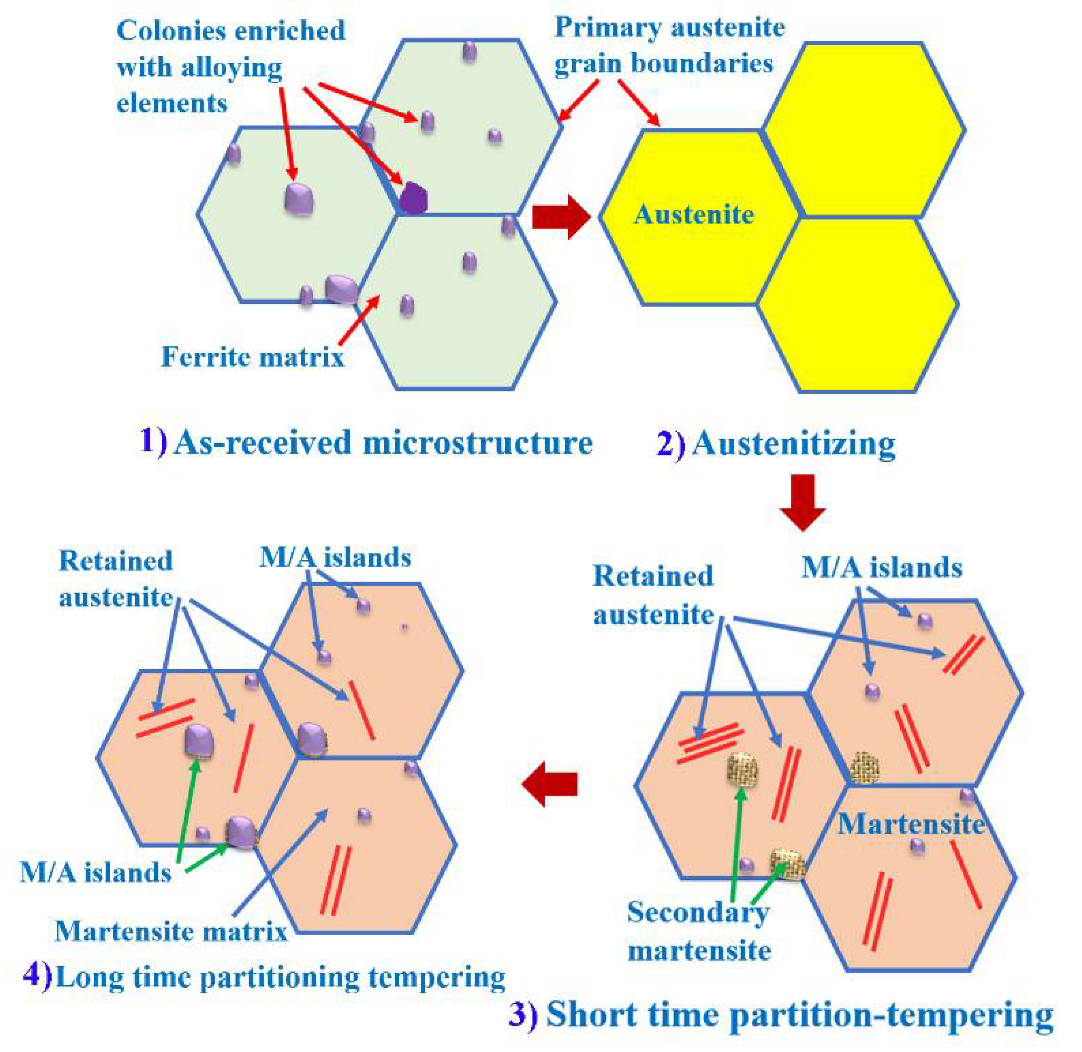
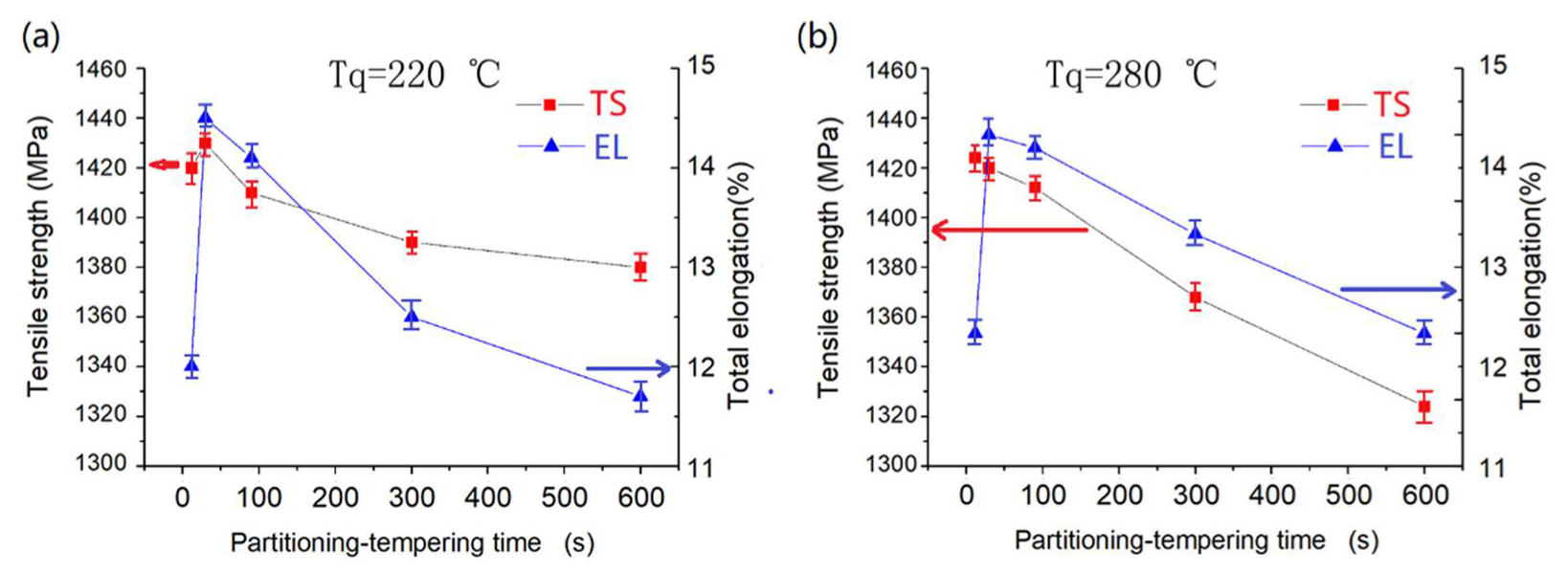
| Fe | C | Si | Mn | Nb | Mo | Cr | S | P |
|---|---|---|---|---|---|---|---|---|
| balance | 0.21 | 1.51 | 1.8 | 0.028 | 0.157 | 0.025 | 0.003 | 0.004 |
Disclaimer/Publisher’s Note: The statements, opinions and data contained in all publications are solely those of the individual author(s) and contributor(s) and not of MDPI and/or the editor(s). MDPI and/or the editor(s) disclaim responsibility for any injury to people or property resulting from any ideas, methods, instructions or products referred to in the content. |
© 2022 by the authors. Licensee MDPI, Basel, Switzerland. This article is an open access article distributed under the terms and conditions of the Creative Commons Attribution (CC BY) license (https://creativecommons.org/licenses/by/4.0/).
Share and Cite
Zhong, N.; Yang, S.; Liu, T.; Zhao, Y.; Li, W.; Li, W.; Wang, X. Effects of Compositional Inhomogeneity on the Microstructures and Mechanical Properties of a Low Carbon Steel Processed by Quenching-Partitioning-Tempering Treatment. Crystals 2023, 13, 23. https://doi.org/10.3390/cryst13010023
Zhong N, Yang S, Liu T, Zhao Y, Li W, Li W, Wang X. Effects of Compositional Inhomogeneity on the Microstructures and Mechanical Properties of a Low Carbon Steel Processed by Quenching-Partitioning-Tempering Treatment. Crystals. 2023; 13(1):23. https://doi.org/10.3390/cryst13010023
Chicago/Turabian StyleZhong, Ning, Songpu Yang, Tao Liu, Yuantao Zhao, Wenge Li, Wei Li, and Xiaodong Wang. 2023. "Effects of Compositional Inhomogeneity on the Microstructures and Mechanical Properties of a Low Carbon Steel Processed by Quenching-Partitioning-Tempering Treatment" Crystals 13, no. 1: 23. https://doi.org/10.3390/cryst13010023
APA StyleZhong, N., Yang, S., Liu, T., Zhao, Y., Li, W., Li, W., & Wang, X. (2023). Effects of Compositional Inhomogeneity on the Microstructures and Mechanical Properties of a Low Carbon Steel Processed by Quenching-Partitioning-Tempering Treatment. Crystals, 13(1), 23. https://doi.org/10.3390/cryst13010023






